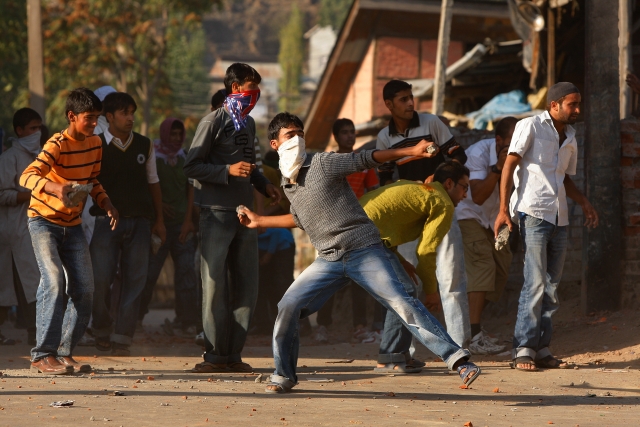Snapshot
-
The modus operandi of the Maoists in Bastar and Islamists in Kashmir is exactly the same.
They are opposed to development and fear education.
On 22 February this year, a group of students owing allegiance to leftist student unions raised azadi slogans at Ramjas College, in New Delhi. The video is there on the internet for all to see. The slogans raised were Kashmir maange azadi, Bastar maange azadi among others.
We have heard the slogan Kashmir maange azadi before at Jawaharlal Nehru University (JNU). But it was the first time that students chanted Bastar maange azadi. And why wouldn't they? It is exactly the same ideology that feeds and nurtures both the separatist groups.
The sinister thread that connects the Islamists in Kashmir and the Maoists in Bastar doesn't stop at mere sloganeering. Both are separatist groups using acts of terror and violence to destabilise the Indian state. The ultimate aim of both Maoists and Islamists is the Balkanisation of India.
The modus operandi of the Maoists in Bastar and Islamists in Kashmir too is exactly the same.
First, they oppose all development in the region by stalling infrastructure projects like the construction of roads and bridges. The attack on the Central Reserve Police Force (CRPF) battalion in Sukma happened while the soldiers were supervising road construction in Bastar. Maoists have attacked road construction labourers and contractors in the past and have even burnt down construction equipment. Earlier this month, Kashmiri separatists forced a shutdown on the valley because they did not want the Prime Minister to inaugurate the 10-kilometer long Chenani-Nashri tunnel in Kashmir. Both Maoists and Islamists fear infrastructure development, as increased connectivity helps in bringing people into the mainstream, thereby weakening their hold over the local people.
The Islamists of Kashmir and the Maoists of Bastar fear education, too. Young people are the chief recruits for both groups, and it is easier to attract illiterate young people, who have no hope for a future, to the movement than youngsters who see a ray of hope and a bright future in India through education. Maoists and Islamists therefore burn state-run schools or forcefully shut them down. The local population is then forced to depend upon the mercy of these separatist groups to access the most basic of facilities.
They first deny people access to basic infrastructure and education, shutting down every chance of a bright future that they might have, and then argue that local people take to arms as 'there is no development in the region’. This circular argument has been repeated many times by the Islamists in Kashmir and the Maoists in Bastar.
In Kashmir as well as in Bastar, women and children are used as human shields to attack the forces, while the actual arms-wielding assault party follows in the rear. In Kashmir, there is a careful mobilisation of school kids and women as stone-pelters who serve as a cover for the arm-toting terrorists in the rear. The Supreme Court of India had expressed concerns over Kashmiri separatists increasingly using minors as human shields while confronting the forces. In Bastar, when the assault party of the Maoists attacks the forces, they first send women and children ahead, like they did in Sukma yesterday. If the forces fire in retaliation, Maoist and Islamist sympathisers can always cry 'human rights abuse’, which is then taken up by the intellectual back-room boys and girls of the two movements.
Neither the Islamists of Kashmir nor the Maoists of Bastar want to resolve their issues through discussion or negotiations. No matter how hard the Indian state tries to assimilate the local people into the mainstream, Maoists, as well as Islamists, resist it with all their might. It is in their interest that the local population remains uneducated, poor, dispossessed and unhappy.
Lastly, the biggest common factor among the Islamists of Kashmir and the Maoists of Bastar are the people supporting them. It is the same group of ‘left-leaning’ intellectuals ensconced in academic hidey-holes like JNU and the Tata Institute of Social Sciences (TISS) and newsroom studios, who provide the Islamists and Maoists intellectual legitimacy.
A successful war depends as much upon ideological warfare as it depends upon the manoeuvres on the battlefield. The job of these urban terrorists is to legitimise the acts of violence by the Maoists and Islamists and lend a romantic halo to their story. Which is why seditious slogans inciting people to break India are passed off as ‘freedom of speech’ and a hardline terrorist like Burhan Wani is humanised as a ‘schoolmaster’s son with a bright future who was led astray’. In the context of Bastar, the urban terrorists’ job is to rationalise the acts of unspeakable violence and terror by the Maoists by inventing catchy phrases like ‘Gandhians with Guns’, as Arundhati Roy once famously described them.
We might get the impression that the battle against the Indian state is being fought in the valley of Kashmir or the jungles of Bastar, but the real war is being fought in India’s cities, thousands of miles away from both Kashmir and Bastar. It is being fought in news studios, in universities and colleges and seminars and symposia. The fingers that pull the trigger might belong to the Maoists or Islamists, but the firepower is provided by the urban terrorists that you will find all around you, in academia, media, films and even in the government. The gun-toting puppets may be in Bastar and Kashmir, but the people who pull their strings are hiding in our midst.
